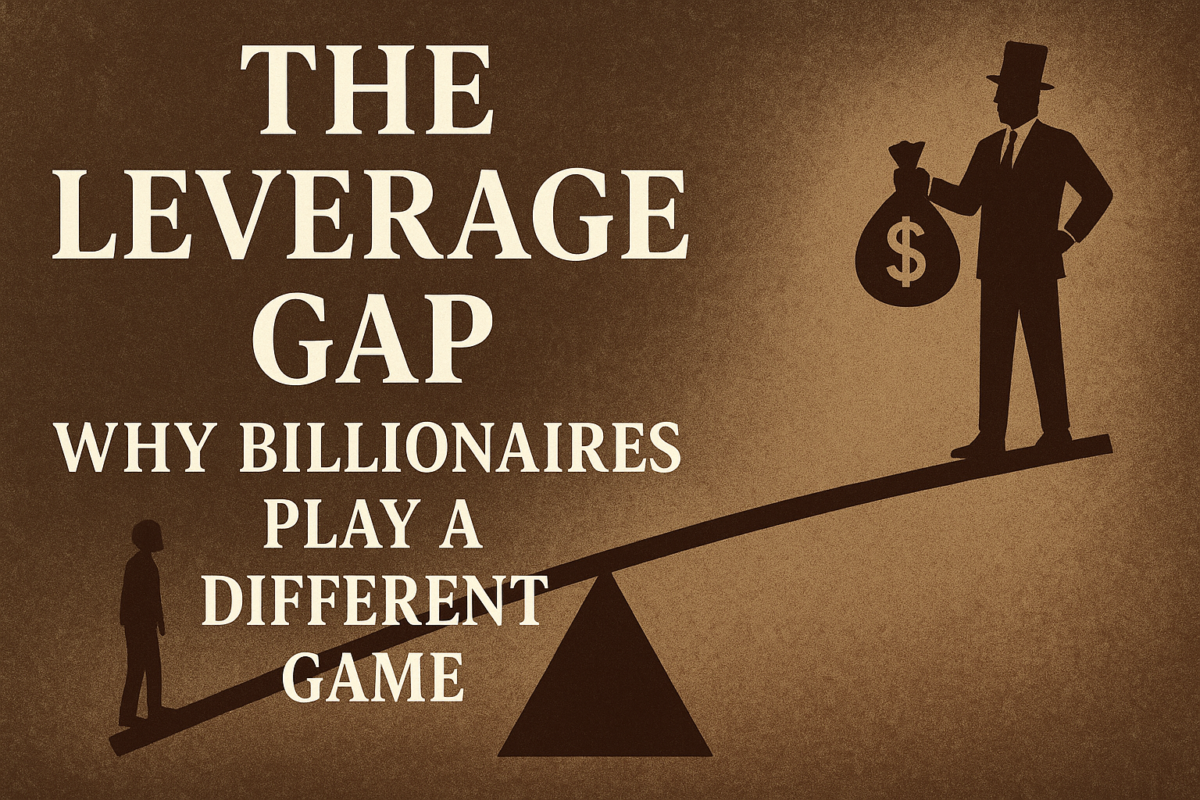There’s a comfortable narrative we tell ourselves about wealth: work hard, save diligently, invest wisely, and prosperity follows. It’s not entirely wrong—for building comfortable wealth, this formula works. But it fundamentally misunderstands how billionaires operate. They’re not playing the same game at all.
Two Different Paths to Wealth
The millionaire next door built their fortune through decades of disciplined effort. They showed up every day, climbed the corporate ladder, started a successful business, saved 20% of their income, and let compound interest work its magic. Their wealth is linear—more hours, more years, more savings equals more money. It’s respectable, admirable, and achievable.
Billionaires didn’t get there by working harder or longer. They got there by identifying and exploiting massive leverage opportunities that most people never see or can’t access. While the millionaire was optimizing their 401k allocation, the billionaire was structuring deals that could multiply capital by 10x, 100x, or more in a single move.
Understanding Financial Leverage
Leverage, in its simplest form, means using a small amount of resources to control or influence something much larger. In finance, it’s borrowing money to amplify potential returns. But for billionaires, leverage extends far beyond just debt.They leverage other people’s money, other people’s time, other people’s infrastructure, regulatory frameworks, information asymmetries, and market inefficiencies. They’re constantly scanning for situations where they can deploy relatively small amounts of capital or effort to capture disproportionate returns.
Consider real estate at different scales. A hardworking professional might buy a rental property with a mortgage, managing it themselves, earning modest cash flow and appreciation. That’s leverage, technically—they’re using the bank’s money. But a billionaire identifies an entire distressed real estate portfolio, structures a deal with institutional investors, uses tax advantages and depreciation strategies, improves operations at scale, and exits for multiples of their initial investment—all while personally contributing a fraction of the total capital.
The Arbitrage Mindset
Arbitrage is about exploiting price differences in different markets or forms. Classic arbitrage might be buying gold cheaper in one market and selling it for more in another. But billionaire-level arbitrage operates on different dimensions entirely.They arbitrage time—seeing trends years before they become obvious and positioning accordingly. They arbitrage information—having insights or connections that reveal opportunities invisible to others. They arbitrage regulatory environments—understanding how different jurisdictions treat the same activity differently. They arbitrage capital structures—knowing when debt is cheaper than equity, or when a particular financial instrument is mispriced.
Warren Buffett’s early arbitrage trades are instructive. He wasn’t just working harder than other investors. He was identifying situations where market prices didn’t reflect underlying value, often due to mergers, liquidations, or special situations that created temporary mispricings. The profit came from seeing what others missed and having the capital to act on it.
Access and Scale: The Invisible Barriers
Here’s the uncomfortable truth: most leverage and arbitrage opportunities are simply not available to ordinary investors, no matter how smart or hardworking they are.
Minimum investment amounts lock out smaller players. The best private equity deals, hedge fund strategies, and venture capital opportunities require millions in minimum commitments. Regulatory frameworks, ironically often designed to “protect” small investors, restrict access to sophisticated investments to accredited investors—those who already have significant wealth.
Network effects compound these advantages. Billionaires operate in circles where multi-million dollar opportunities are casual dinner conversation. They get first looks at deals, introductions to key players, and inside information (legal insider information—understanding industry trends before they’re public) that simply doesn’t reach ordinary investors.
Scale itself becomes leverage. When you can write a $100 million check, you get different terms than someone who can invest $100,000. You get board seats, preferential liquidation preferences, and the ability to influence outcomes. Your phone calls get returned. Your proposals get serious consideration.## The Compounding Effect of LeverageOnce you’ve successfully leveraged one opportunity, the next becomes easier. Your first successful real estate deal gives you credibility for a larger one. Your first successful startup exit makes you an attractive angel investor for the next generation. Your first major acquisition gives you the infrastructure and expertise to do bigger deals.This creates a wealth acceleration curve that looks nothing like the steady linear growth of working and saving. It’s exponential. The gap between those operating with leverage and those without it doesn’t grow arithmetically—it grows geometrically.
Consider two people starting with $1 million. Person A invests conservatively, earns 8% annually, and after 20 years has about $4.6 million. Impressive. Person B identifies high-leverage opportunities, deploys capital strategically, and averages just 25% annual returns (not uncommon in private equity or venture capital, though with higher risk). After 20 years, they have $86.7 million. Same starting point, completely different outcome.
The Working Hard Trap
This isn’t to diminish the value of hard work. Building from nothing to millionaire status through diligent effort is genuinely difficult and praiseworthy. But we need to be honest about its limitations.
Working harder has natural ceiling. You can’t work 10x more hours. You can’t become 10x more productive at your job. You can’t save 10x more when you’re already saving 20% of your income. The math simply doesn’t support billion-dollar outcomes through personal labor alone.The Forbes 400 isn’t populated by people who worked the most hours or had the best work ethic—though many worked plenty hard. It’s populated by people who identified and captured extraordinary leverage opportunities. They built companies that scaled without proportional increases in their personal effort. They made investments that multiplied independent of their ongoing labor. They created or captured value in ways that decoupled their wealth from their time.
Information Asymmetry as the Ultimate Advantage
Perhaps the most powerful form of leverage available to billionaires is information—knowing things others don’t, or knowing them earlier.This isn’t illegal insider trading. It’s being positioned to see trends first, to understand implications faster, to recognize patterns that aren’t yet obvious. When you’re on multiple corporate boards, when you’re funding cutting-edge research, when you’re connected to policymakers and industry leaders, you see the future before it arrives.
By the time an investment opportunity makes it to the front page of the Wall Street Journal, billionaires have often already positioned themselves years earlier. The arbitrage opportunity—the gap between current price and future value—has already closed or significantly narrowed.## Can This Be Replicated?The honest answer is: not at the same scale, but the principles can be applied.
You can seek leverage in your career by building skills that scale—creating content, building software, developing systems rather than just working in them. You can look for arbitrage in smaller markets—price differences in local real estate, undervalued small businesses, inefficiencies in niche industries.You can build networks deliberately, positioning yourself to see opportunities earlier than your peers. You can think in terms of asymmetric risk-reward—situations where your potential upside far exceeds your downside, even if success is uncertain.But we should be clear-eyed: the most powerful leverage opportunities require capital, access, and networks that take time to build. The gap between working hard for wealth and leveraging for wealth is real, structural, and significant.
The Uncomfortable Conclusion
Billionaires aren’t billionaires because they worked a thousand times harder than millionaires. They’re billionaires because they played a different game entirely—one based on identifying and exploiting massive leverage and arbitrage opportunities that compound exponentially.
This doesn’t make hard work valueless. For most people, it remains the foundation of financial stability and comfort. But if we’re being honest about how extreme wealth is actually built, we need to acknowledge that it’s fundamentally about leverage and opportunity capture, not just effort and time.
The question isn’t whether to work hard—that remains valuable. The question is whether you’re positioned to identify, access, and capitalize on leverage opportunities when they appear. For most of us, the answer is that we’re playing a different game entirely, with different rules, different possible outcomes, and different definitions of success.
Understanding this gap doesn’t diminish anyone’s achievements. It just makes us more honest about how wealth actually works at different scales.


